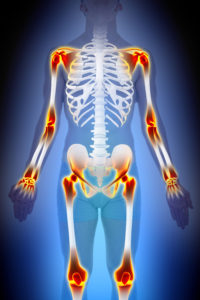
Recently, I have been working with clients who have been experiencing knee pain. After visiting their doctors, it has been confirmed that in some cases it was osteoarthritis and in one instance it was (RA) Rheumatoid Arthritis. What is Rheumatoid Arthritis and how does it differ from Osteoarthritis, one might ask.
Rheumatoid Arthritis can be responsible for inflammation around the joints as well as in other organs and tissues of the body. An autoimmune disease is a condition where body’s tissues are attacked by the body’s own immune system. Persons with autoimmune diseases have antibodies in their blood that attack their own body the resulting inflammation then destroys the tissue concerned. Rheumatoid Arthritis is a chronic illness that can last for years, but you can go long period of times without symptoms.
Osteoarthritis also known as degenerative arthritis is a non-inflammatory condition, primarily caused by damage as a result of wear and tear, trauma or disease happening to the cartilage of the joint. It often happens when a bone thickens to compensate for the deterioration of the normally smooth cartilage becoming rough with age. It normally affects elderly people but can also be found in teenagers. It commonly involves knees, fingers, and hips. The fact that is called non-inflammatory however does not mean that there is no inflammation involved, it just means that the inflammation is not the cause of the problem.
Now that we identified what each condition is, with exercise, we can ease some of the pain associated with these conditions. Since RA causes stiffness in the joins and pain, the last thing you want to do is be INACTIVE. Staying active is not only beneficial for your general health, it’s also a way to strengthen your joints, improve your range of motion, and give you the opportunity to take part in extracurricular activities. For people with rheumatoid arthritis (RA), it’s best to start with an individualized program with a physical therapist, that can develop a program with exercises that can protect vulnerable muscles while strengthening surrounding muscles. For people with osteoarthritis (OA), most successful programs involve a combination of approaches tailored to the patient’s needs, lifestyle, and health. most programs include ways to manage pain and improve function. The four goals of OA treatment is:
-to control pain
-to improve joint function
-to maintain normal body weight
-to achieve a healthy lifestyle
Most importantly, the best way to treat both conditions is with a well-rounded exercise program that should include the following elements:
Aerobic conditioning. Exercises that increase your heart rate and breathing rate has many benefits, including lowering your chances of developing conditions such as diabetes, stroke and heart disease. When choosing aerobic exercises, one should consider low impact exercises such as swimming, bicycle riding, and walking.
Resistance training. Weak muscles, whether due to inactivity or to the side effects of medications like steroids, can diminish your stamina and leave joints less stable. Isometric exercises – exercises that involve muscle contractions with no movement can be a great way to start resistance training. Once pain is under control free weights or weight machines are good options for building muscle and increasing strength.
Stretching and flexibility exercises. Joints damaged by arthritis don’t move with the same ease or to the same degree (a.k.a range of motion) as healthy joints. That makes activities that lengthen and strengthen the muscles surrounding your joints, such as stretching exercises, tai chi, and yoga.
Balance exercises. Having rheumatoid arthritis can cause problems with gait and balance, leaving you more vulnerable to stumbles and falls. A physical therapist can recommend individualized balance-training exercises. These exercises may include standing on one leg or exercises to strengthen core muscles.
Weight Control. If you are overweight, weight loss can reduce stress on weight-bearing joints, limit further injury, increase mobility and reduce the risk of associated health problems.
So, with everything you just read, I hope you are encouraged to keep moving. It may be a little painful in the beginning but it will get easier, so NEVER GIVE UP!
With your health and success in mind,
Natonée